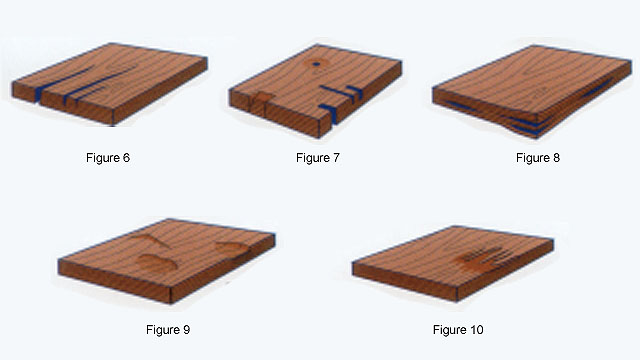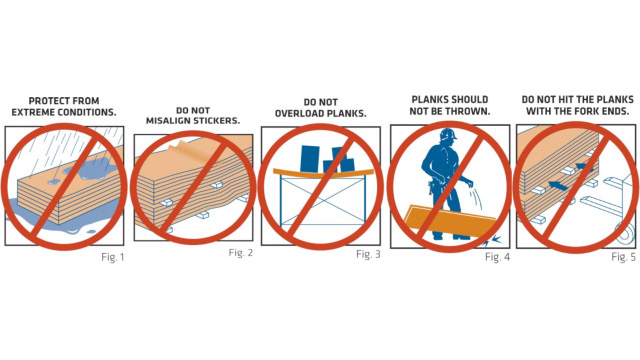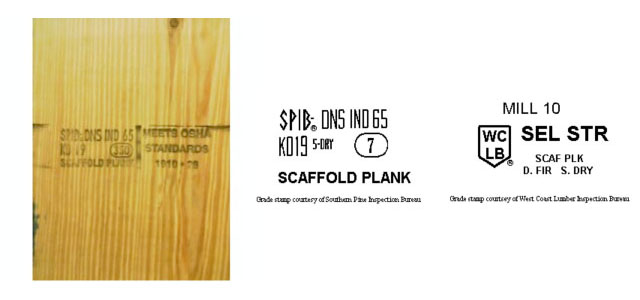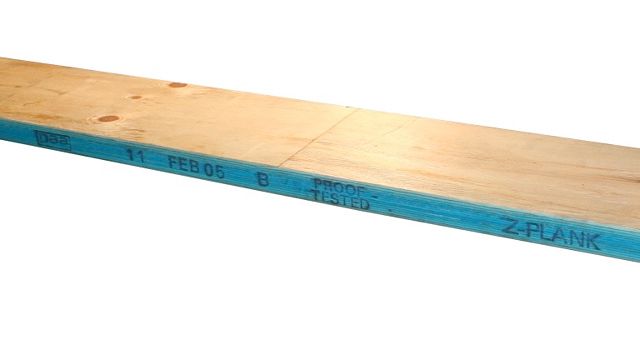Know your plank
Planks and decking
By Masonry
Before a brick or block wall can go up, the basics have to be considered. Safety precautions are paramount, and that ranges from a properly fitting hard hat to the condition and strength of the planks you are using on your scaffolding. To learn more about the inspection, storage and purchasing considerations for planks, Masonry consulted an expert in the industry, Jared Kennison, V.P. and general manager of Kennison Forest Products Inc. Following is what he had to say.
Masonry: Talk about importance of routine inspections in the scaffold plank industry, particularly, evaluation and visual inspection.
Jared Kennison: One of the most important pieces of equipment used in masonry is scaffold plank. It can literally make the difference between life and death. It is one of those products that takes extreme abuse, while still being used on a jobsite. Every mason contractor should add routine plank inspection to his safety program for this reason.
All legitimate scaffold plank suppliers offer inspection and storage information that is widely accepted in the industry. The most common damage or “caused defect” seen today is end splits. This is when the end separates over time, due to abuse or wet/dry exposure. If the length of the end split exceeds the width of the piece, the contractor should cut back the plank to a shorter length or take it out of service.
It is very important to inspect your scaffold planks routinely for all types of damage or abuse. This must be done by a “qualified” or “competent” person. OSHA Safety and Health Standards and Scaffold Industry Association defines a “qualified person” as one who, by possession of a recognized degree, certificate or professional standing or by extensive knowledge training and experience, has demonstrated successfully the ability to solve or resolve problems relating to the subject matter, the work or the project. The Scaffold and Access Industry Association (SAIA) makes a Solid Sawn and LVL Pocket Hand Book that is an excellent reference for inspection and storage. Bottom line: When in doubt, throw it out.
Visual inspection, proper handling and storage are the best ways of ensuring safe performance of solid sawn and laminated scaffold planks. Following are other things to look for.

Saw cuts, drilled holes and notches: Saw cuts, drilled holes or notches will reduce the plank's load-carrying capacity. These planks should be removed from service and inspected by a qualified person. See Figure 7.
Edge splits: A separation of the narrow edge of the plank usually is caused by forklift damage. If an open split is detected, remove the plank from service. See Figure 8.
Dents, gouges and depressions: Dents may reflect internal structural damage. Remove these from service and get them inspected by qualified person. See Figure 9.
Face breaks: These are irregular cracks across the face of the scaffold plank, and are usually a result of overloading. Face cracks dramatically reduce the strength of the plank. Remove planks with face breaks from service. See Figure 10.
Other physical signs include discoloration, odor or soft, spongy wood. Remove planks with these characteristics from service. Remember to immediately remove damaged scaffold planks from service as damaged planks may result in injury or death.
Masonry: Can you discuss the importance of proper storage of scaffold planks, and provide a few tips?
Kennison: It has been very important, especially since business for many has been slow the last few years. While most of the planks were not on a jobsite, they were not stored properly, causing the plank to rot or decay. This is a common problem in storage that can be avoided. These simple steps could extend the life of your plank and prevent future losses.

Scaffold plank storage
- Keep scaffold planks dry. The strength and performance of a scaffold plank is reduced by increased moisture.
- Store planks in a dry, well-ventilated area. Storing planks in an area that is wet or not well ventilated will accelerate plank deterioration. Always allow wet planks to dry quickly by providing proper air circulation.
- Protect planks from extreme weather conditions, including excessive exposure to water and temperatures exceeding 150 degrees Fahrenheit. Store planks under roof or under a porous cover that will shed water while allowing moisture to escape. See Figure 1.
- Keep planks stacked off the ground and supported by stickers spaced no more than eight feet apart. Make sure the bundle stickers are aligned with those on the ground. This allows easy fork lift access and air flow. Misalignment of stickers can damage the planks by creating a bow. See Figure 2.
- Do not store heavy objects on the planks.
Recommended handling methods
- Do not overload the planks; refer to the span charts for loading capacity. Immediately remove planks from service that have been overloaded, and visually inspect prior to reusing. See Figure 3.
- Throwing planks from scaffolding may cause damage. A thrown plank should be inspected and evaluated before reuse. See Figure 4.
- Do not push or hit bundles of scaffold planks with the fork lift ends. Stickers should be of the thickness that will allow easy access by the fork lift forks, without causing damage to the planks. See Figure 5.
Kennison: Due to slower business in some parts of the country, there has been a large amount of used scaffold planks for sale by contactors either going out of business or reducing inventory. This can be an attractive offer to a contractor, because he can purchase used planks at a fraction of the cost of buying new planks.
The problem is that the contractor has no idea what kind of stress the used planks have taken since it has been in service. Most would believe that, just because the planks look fine to them, there is no cause for concern. This is simply wrong. Years or even months of workers, equipment and material being loaded onto the scaffold planks can decrease its overall capacity and dependability. The liability still rests in the hands of the present owner.
Furthermore, used scaffold planks that are embossed with another company’s name could implicate that company if an accident occurs. Any money saved when purchasing used planks would pale in comparison to dealing with an accident or litigation due to plank failure.
Masonry: What should contractors look for when purchasing scaffold plank?
Kennison: First of all, contractors should look for reputable, well-known suppliers in the industry. They should get references on suppliers, especially when it comes to quality, customer service and meeting the required standards.
When contractors are looking for suppliers of OSHA-compliant, solid sawn scaffold planks, they should assure each plank has the following features:
- An OSHA marking that signifies it meets OSHA standards for solid sawn scaffold plank
- All solid sawn wood planks should be rated as “scaffold plank” grade and should be certified by, or bear the grade stamp of, a grading agency approved by the American Lumber Standards Committee (ANSI A10.8-2001)

- A third-party inspection agency logo (LVL mills must be inspected by an independent agency to ensure they meet all manufacturing requirements)
- A manufacturers name and mill number (notes manufacturer and date they were made)
- A “SCAFFOLD PLANK” stamp
- An OSHA marking that signifies it meets OSHA standards for LVL scaffold plank
- Design properties must be published by the manufacturer; LVL scaffold plank that are proof tested are recommended, but not required.
Originally published in Masonry magazine.
About the Author
Masonry, the official publication of the Mason Contractors Association of America, covers every aspect of the mason contractor profession - equipment and techniques, building codes and standards, business planning, promoting your business, legal issues and more. Read or subscribe to Masonry magazine at www.masonrymagazine.com.



















